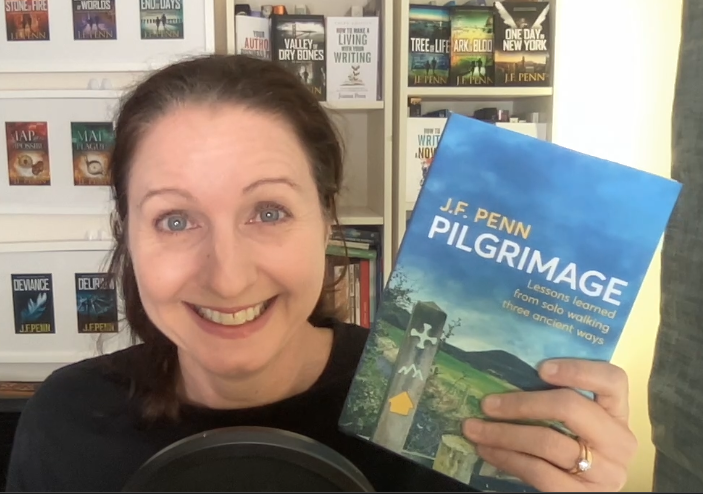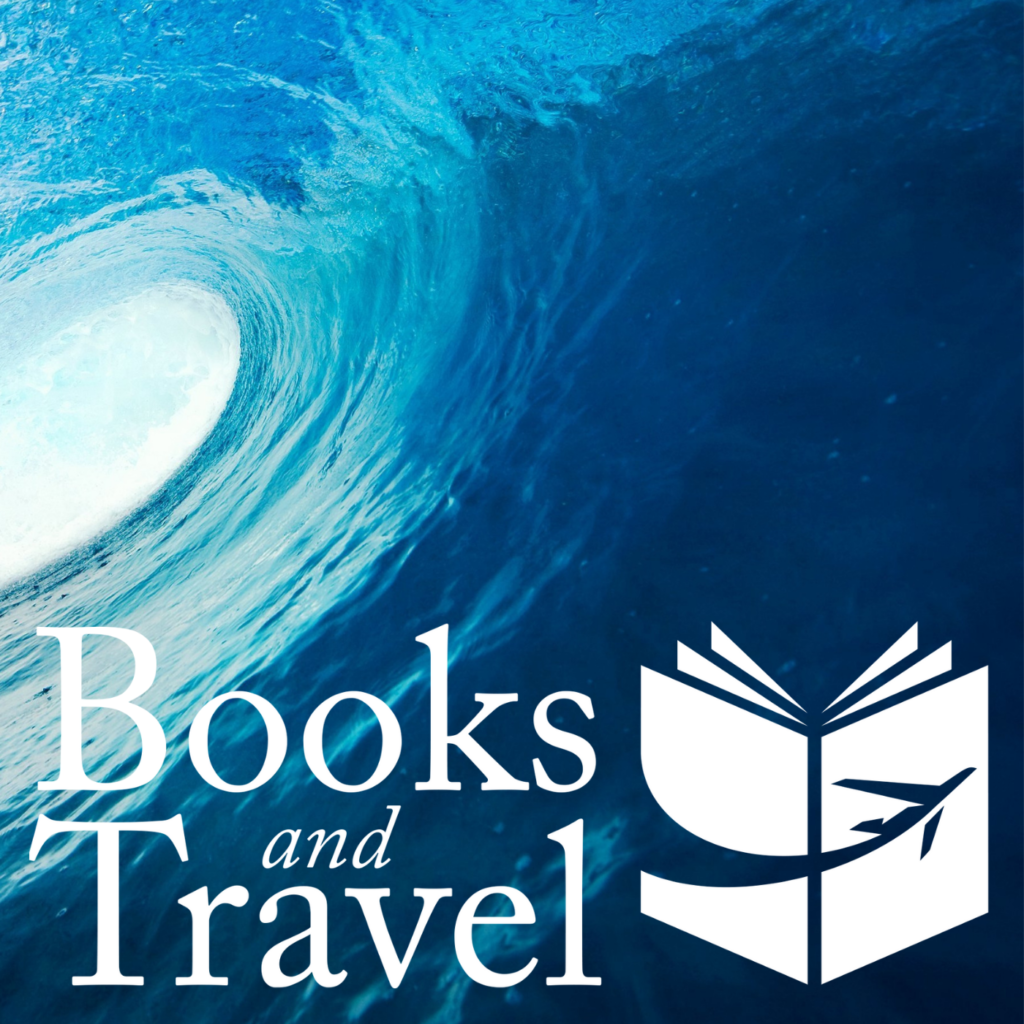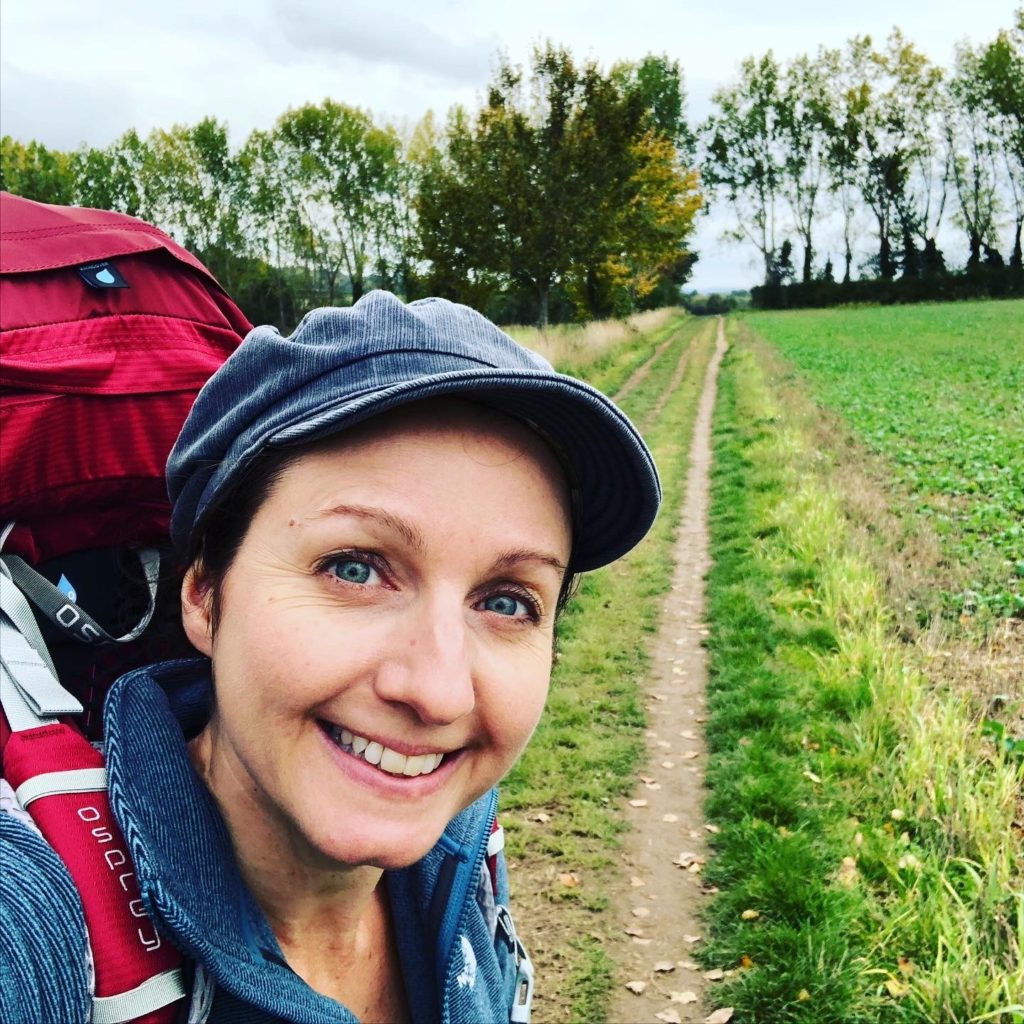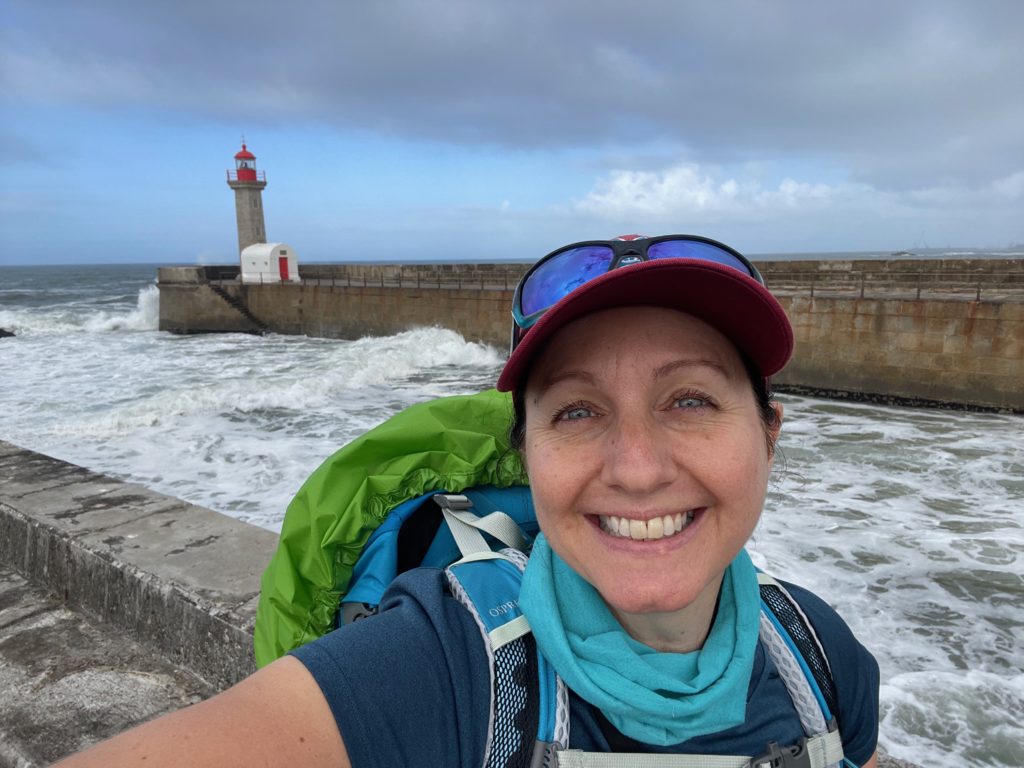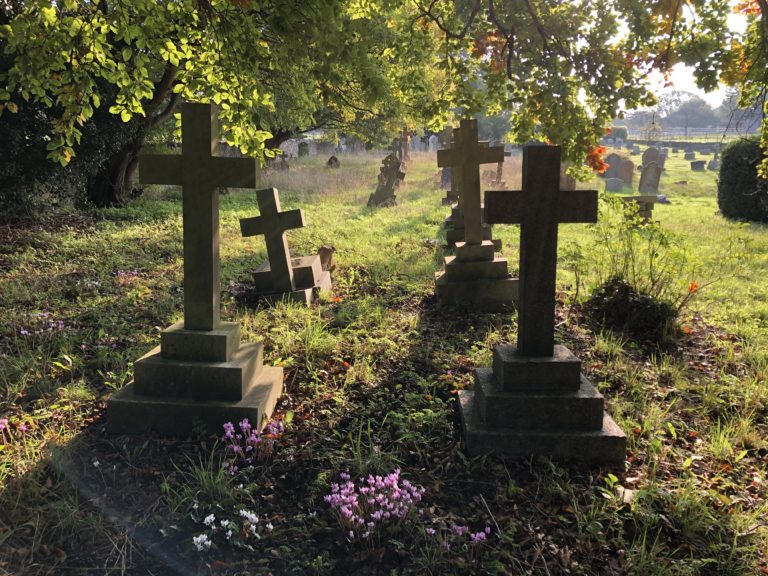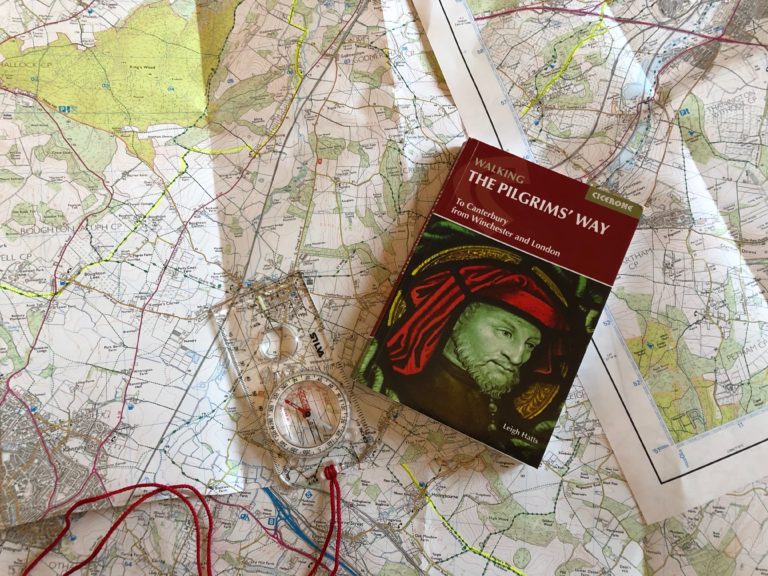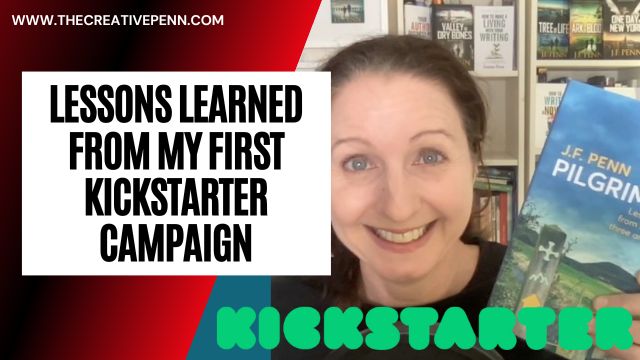How can you write a memoir that is emotionally honest and revealing enough for readers to care, and cope with the inevitable fear of judgment that evokes? How can you write about real places and people in memoir?
Why is editing a memoir so challenging and what should you keep in mind around publishing and marketing choices? J.F. Penn gives her tips after writing her midlife solo travel memoir, Pilgrimage: Lessons Learned from Solo Walking Three Ancient Ways.
Thanks to everyone who backed my Kickstarter for Pilgrimage, and to my Community at Patreon.com/thecreativepenn, who help fund the extra time it takes to produce these solo episodes.
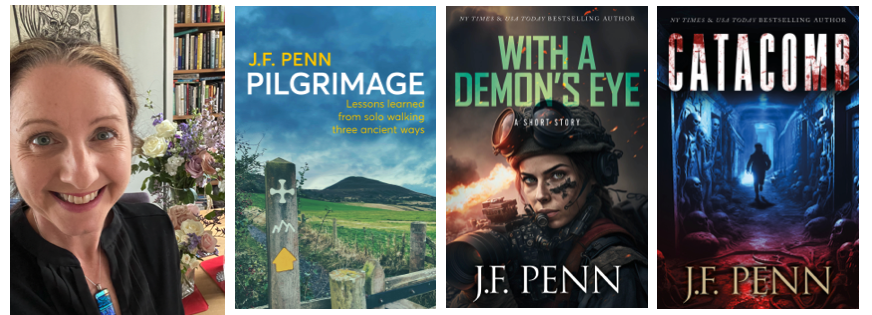
J.F. Penn is the Award-nominated, New York Times and USA Today bestselling author of thrillers, dark fantasy, crime, and travel memoir. Jo lives in Bath, England with her husband and two British short-hair cats, and enjoys a nice G&T.
You can listen above or on your favorite podcast app or read the notes and links below. Here are the highlights and the full transcript is below.
Show Notes
- What kind of book do you want to write?
- The particular challenge of memoir
- Vulnerability and emotional honesty
- Capture your experience through writing and photos
- Writing about real people and places
- Character arc
- Truth (capital T) vs truth (small t)
- Specific sensory detail
- The first draft and killing your darlings
- Publishing choices and formats
- Marketing. Finding an audience for a different type of book
You can buy Pilgrimage in all the usual formats from my store, JFPennBooks.com as well as the special hardback and paperback with photos from the trips. It’s also on all the usual stores in all the usual formats, or order from your library or local bookstore.
If you want to read about the day-by-day pilgrimages, and see photos from the routes — The Pilgrims Way and the St Cuthbert’s Way in the UK, and the Camino de Santiago Portuguese Coastal — go to
https://www.booksandtravel.page/pilgrimage-resources/ for all the links to my trips, gear list, questions to think about, and interviews.
You can find my lessons learned from the campaign and more tips for Kickstarter at https://www.thecreativepenn.com/selldirectresources/
If you want more interviews on writing memoir and book recommendations, go to https://www.thecreativepenn.com/writing-memoir/
Introduction
I wrote this little book about writing travel memoir as a stretch goal for the Backers of my Pilgrimage Kickstarter in February, 2023. Thank you so much if you supported the campaign!
I thought I would turn these notes into a craft book at some point, but as I shared in the episode on my 15-year Creative Pivot, I have a lot of other projects on the go, and I wanted to share this information with my wider community in the hope that it will help you if you want to write memoir of any kind, or even just non-fiction with more personal elements.
It is designed to be read or listened to after the Pilgrimage book as there may be spoilers, and also it makes more sense to be read in context. You can buy Pilgrimage at my store, www.jfpennbooks.com and also on all the usual stores in all the usual formats, but hopefully the information is still useful even if you haven’t read the book.
1. What kind of book do you want to write?
If you feel the urge to write a memoir, it might still take some time to work out what the hell you’re writing!
I’ve been wanting to write a travel book for years, but I didn’t know exactly what I wanted to write. As a discovery writer, I figure out what I’m writing once I actually start writing it, so although I have written journals related to my travels for decades, nothing emerged as a coherent potential book.
To take a step back, I have a lot of potential ways into a travel book.
My mum took me and my brother to live in Malawi, Africa, in the early 1980s and my memories of going to school there are full of the wonder of being ‘somewhere else.’

I still remember looking out at the sunrise over the Sahara desert from the plane cockpit back in the days when they let kids go up there. Those were also the days when people still smoked on planes, and I remember how my mum made us breathe through handkerchiefs to save us breathing too much in.
Those early years may have triggered my wanderlust, and I started reading travel books in my teens. The Life of My Choice by Wilfred Thesiger, Seven Pillars of Wisdom by T. E. Lawrence, The Songlines by Bruce Chatwin, and so many more. I wanted to be like them and travel the world, experiencing everything and writing about my adventures.
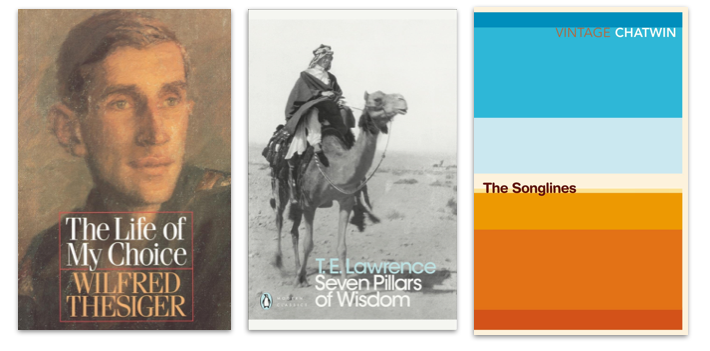
Fast forward more than thirty years and I was writing non-fiction for authors, and also fiction as J.F. Penn, incorporating my more recent travels into my stories. Morgan Sierra, in my ARKANE series in particular, is my alter-ego and her adventures and thoughts are often my own. Although of course, I am not ex-Israeli military; I don’t know Krav Maga, and I don’t chase bad guys!
But despite all my published work, I still had a desire to write travel, and so in 2019, I started BooksAndTravel.page, with articles and photos about travel and books, as well as a bi-monthly podcast.
The goal was to use the site to write memoir-style essays and create thematic episodes around my travels as well as interview other writers, and hopefully, figure out what I wanted to write in terms of a travel book, and build an audience along the way.
I did lots of solo episodes on my Books and Travel Podcast including why I travel, the importance of home in difficult times, the three trips that changed my life, Venice, scuba diving, Oxford, Australia, Bath, and more. [Episodes are linked on this page.]
I had ideas for starting a separate business around guided trips and retreats, as well as books and other travel-related products.
Then, in early 2020, the pandemic struck, and the world changed.
The travel industry changed too, and I also learned more about how the business side of it worked. The Books and Travel Podcast sustained me during the years of no travel, and slowly, I found examples of books that enabled me to see a path to writing my own.
At first, I thought I would write an A to B travel narrative with personal elements, like Alastair Humphreys’, My Midsummer Morning. [Interview with Alastair here.]
I thought I might have several such books, one per walk/solo trip, similar to Holly Worton’s Alone on the Ridgeway. [Interview with Holly here.]
But after walking the Pilgrims’ Way, I realized I didn’t want to write a book about individual routes. I didn’t have enough material to make it a worthwhile narrative, and it just didn’t feel right.
Also, if I started writing these kinds of books, then I would need to write them for each trip. I still wanted to write my other books, and I just couldn’t see how I would have time for it all.

Then I discovered travel books which are more a series of trips hung around thematic chapters, and that seemed like a better fit for my project.
Open Road: A Midlife Memoir of Travel Through the National Parks of the USA by Toby Neal was a great example [Interview with Toby here], as well as Not Quite Lost: Travels Without A Sense of Direction by Roz Morris.[Interview with Roz here.]
Both have chapters about different places interspersed with the emotional aspects of memoir.
In addition, although not specifically travel, Rachael Herron’s A Life in Stitches is also similar as a series of emotionally resonant linked essays about knitted garments. Rachael also has a craft book, Fast Draft Your Memoir, which is useful for the writing craft aspect. [Interview with Rachael here.]
TIP: Find books that are similar to what you want to write and model them.
There are lots of different travel sub-genres, and Jeremy Bassetti has a great article about 10 different kinds on his site, Travel Writing World. They include the travelogue, the quest, the investigation, the big idea, the mode (e.g. cycling), and more. I discussed aspects of travel writing with Jeremy in this interview.
I found this to be a critical part of the writing process, as until I had a ‘model’ for my book, I struggled to structure it. Once I knew it would be thematic chapters with vignettes, it was easier to work out what the book might be.
2. The particular challenge of memoir
“Writing the self is a tricky, slippery business.” Cathy Rentzenbrink, Write It All Down: How to Put Your Life on the Page
Before writing, I knew intellectually that memoir might take a lot more time than other kinds of writing, but truthfully, I didn’t expect it to be so for me.
After all, I’ve written over 40 books. I know what I’m doing!
My books usually take a few months to write once I knuckle down to the first draft, and I write pretty clean these days so my edits are not usually significant. I’m a binge writer, or a project-focused writer, which means I don’t write every day, but I work on one project at a time, and put that through to completion, before working on the next.
But it feels like I’ve been writing this memoir for decades — and realistically, I have been as there are elements of my earlier life included.
In an interview I did with Marion Roach Smith on memoir in July 2020, I said,
“I keep walking up to the idea of memoir and then walking away again.”
That’s how it’s been for a long time.
Threads of ideas in the book come from my teenage years, and the idea of walking the Camino itself comes from those early days of faith.
The words that eventually became Pilgrimage were mainly written from the early months of 2020 to the end of 2022, so that’s almost three years and most of those words were discarded, anyway.
I have never taken so long to write a book.
I have never discarded so many words.
I have never wrestled with the material so much as this.
I have never found it this hard to produce a finished book.
And I am so proud of the result.
Pilgrimage is an encapsulation of a snapshot of my life, and all the time it’s taken has been worth it.
This is not to suggest that memoir must take a lot of time, or that books written quickly are less worthy. It just demonstrates that memoir, in particular, is a messy process, and shaping a semblance of your life into a book that others might want to read is more challenging than expected.
Will I write another memoir?
I am 48 next month as I write this (March 2023), and hopefully, I have a lot of life left in me. I don’t expect to write another about pilgrimage or solo walking, but it is likely that at some point, I will write another memoir. But only when aspects of life shape themselves into a personal story worth telling, or another theme I want to address.
Until then, I will write more fiction and non-fiction/self-help books and aspects of my life and my personality and my thoughts will come through in those.
TIP: Let your memoir emerge.
It cannot be forced into being. It may take much longer than you expect to write — but it will be worth it.
3. Vulnerability and emotional honesty
“The truth of writing is the more specific we are, the more universal our experience becomes.”
Rachael Herron, author of Fast Draft Your Memoir, in an interview on memoir on The Creative Penn Podcast, Feb 2018.
I’m writing this in mid-February, 2023. My Pilgrimage Kickstarter finished last week. I sent the ebook and audiobook out yesterday and a few people also have printed copies.
People are reading my words — and it is terrifying. I have always had a fear of judgment and it’s in full force right now.
I haven’t felt this level of fear about a book for a long time, but perhaps that’s what enables memoir to connect with people in a deeper way. We bare our hearts on the page.
Memoir requires emotional vulnerability and the sharing of personal stories and insights, and as such, requires more depth from the writer than other genres. I was absolutely intimidated by this, especially as my story has aspects of depression and suicidal thoughts that I haven’t shared before.
I’m also British and I’m not an over-sharer in general. I was taught to “pick yourself up, dust yourself off, and start all over again,” one of my mum’s favorite mantras when things were difficult. Don’t dwell on the past, just get on with whatever’s next.
But we are all broken, and the last few years of the pandemic have beaten everyone down, and if I didn’t share my difficulties, it would not be a memoir but a travelogue or a trip guide.
Memoir demands emotional depth, and so I included aspects of both physical pain, mental health problems, and even the hormonal rollercoaster of being a woman in midlife.
I questioned whether to include that section, but my depression and insomnia were so closely linked with my hormones, and were so quickly fixed by HRT, that I included it in the hope it would help someone else. And indeed, I have already received emails thanking me for that section.
There were things I edited out.
Things related to people I love that did not serve the story and, therefore, were unnecessary in this book. Other things that I have not processed enough to share at this point.
A finished and published memoir is not therapy. Once you shape it into the final form of a book, it is for others, not yourself.
TIP: Write it all down. Edit later. Be true to the story you want to tell.
From my interview with Alastair Humphreys about his travel memoirs,
“The way to do it well is to be as honest as you dare and as honest as you’re possibly comfortable with, and then a bit beyond. I think my book [My Midsummer Morning] got better the more honest and vulnerable I made myself, which is a difficult thing to do, but simply in terms of if you want to write a good book, then you just have to be honest, lay it on the line.
And you, as a reader, will know that yourself from reading books, the memoirs that grip you are the ones that really go deep, and honest, and vulnerable.”
4. Capture your experience through writing and photos
If you want to write a travel memoir, you have to go on a trip, or more than one, in order to provide the raw material for your book. [You can find the day-by-day trip notes and photos here.]
I primarily use hand-written notes in a journal. For journal geeks, I prefer Leuchtturm A5 hardback with plain paper with a teal/blue/red cover. They are not cheap, but my words are worth it! I usually write with a plain black biro. I also take a lot of pictures with my iPhone.
I prepared for journaling on my pilgrimages by taking a list of questions to consider, because if you don’t help yourself with some prompts, it can be hard to pay attention to specific details. And the best travel books are very specific with details!
Examples include:
- What am I escaping from?
- What is ancient, and what is modern?
- What can I be curious about today?
- What is the shadow or the darkness here?
I printed the questions and stuck them into my journal as a reminder of what I wanted to think about. [The full list of questions are in Pilgrimage.]
I walked in the northern hemisphere autumn (Sept, Oct) for all three of my solo walking pilgrimages, so I woke before dawn most days. I also went to bed early, so I wrote every morning. I was usually too exhausted in the evenings, and the morning was better for writing my thoughts.
During the day, I added notes into my Things app on my phone as a reminder for what I wanted to write about later. Here are some of my notes:
- Finches darting between trees. Hills on the water. Little wading birds. Moon is still high at 8.30 as the sky turns blue.
- Pretty nasty docks and busy urban streets into Vigo.
- La reina eterna on Spanish news. Stopped for espresso. Footage of William and Harry walking behind Diana’s hearse. Feeling weepy.
You can find some more of my daily notes at: www.thecreativepenn.com/dailynotes
I also took a lot of pictures of different kinds:
- Beautiful or interesting pictures of the route, architecture, nature, landscapes, as well as selfies for social media usage later
- Specific photos of details to write about, e.g. plants or signs, stiles, food, my blisters and rashes and minor injuries so I know what day I got them, my gear, receipts from places I visited, screenshots of the map so I could pinpoint where I was when things happened, and many more.
I took many hundreds of photos, most of which I never shared, as they are more functional and for memory aids than beautiful. I was very glad of them later when it came to write about the trips.
I also had my maps and guidebooks, which I referred to before, during, and after each trip.
As a backup, I took pictures of my journal pages every night and synced it with Wi-Fi to my Apple Photos, so even if I lost the physical journal I’d still have my writing.
You could also use audio recording for voice dictation or to record sounds of a place, or to interview people. Or you could use video for personal recollection, or for social media, or to produce a finished product.
I didn’t use either of these, but many travel writers use them effectively. Check out Alastair Humphreys’ video about his Midsummer Morning trip on YouTube.
TIP: Capture more than you will ever need.
Minor things like the brand of beer, or the strange stile, or the person you met one morning may end up more important than you think in the finished book.
Process each trip soon afterwards.
Each experience needs processing time in order to figure out any meaning or deeper layers.
I used my Books and Travel Podcast and website to document each of the routes, which meant I had to go through all of my photos and curate the best ones, as well as write about the day-to-day process. I did this within a month or so of each trip and this helped my initial thoughts to coalesce.
For reference, my daily posts are here: The Pilgrims’ Way, St Cuthbert’s Way, Camino de Santiago.
I also did some solo podcast episodes where I reflected more on the meaning of the walks for the Pilgrims’ Way, This Too Shall Pass, and the Camino, A Pilgrim in the Path of History.
Later, when I came to write the book, I used the transcripts from those episodes in my Scrivener project and excerpted aspects of them into the book.
From my interview with Alastair Humphreys in April 2019,
“When I get home, one of the first jobs I do is just type up the whole diary, which gradually starts to filter things in my head.”
TIP: Spend some time processing each experience soon after returning, writing something for publication on your blog, or in a podcast episode, or video.
Otherwise, it might be years before you revisit the trip and you may have ‘lost’ elements of meaning, or reframed them based on later experience. That doesn’t mean a book written much later is invalid, it just means it will be different — as you are different.
5. Writing about real people and places
This is your story and, as such, is your perspective.
But there are always other sides to any story.
You don’t have to tell them in your book, but you have to understand that others may see a situation differently. If you write about real people in a way that hurts them in some way, or portrays them in a bad light, then there may be consequences.
Only you can decide if you want to go ahead, and obviously, I can’t advise on the legal ramifications.
This ALLi article might be useful around avoiding libel and defamation.
Personally, I suggest writing anything you like in the first draft. Let it rip.
You can’t hurt anyone in a first draft, so write as if no one will ever see it. Password protect the file if you need to! Whatever it takes for you to feel safe when you’re writing.
Then, when you’re ready, and have some distance, edit the manuscript with fresh eyes and a clear perspective.
If you don’t have distance and a clear perspective when you edit, if you still have an axe to grind, or you’re seeking revenge, or you’re trying to hurt someone with your words, then put the manuscript aside, get therapy or whatever you need to do, and come back to it when you are clear and can focus on what serves the book and the reader.
While I have written about Jonathan and my family in a limited way, my memoir is mainly about walking solo and my individual challenges, so I wasn’t worried about needing to change anything.
Jonathan and my mum read the book, but only when it was finished, and neither asked for any changes. They understand I am a writer, and I process my life through writing, and while they were sad that I had a difficult time, they also appreciated that I was out the other side by the time the book was done.
In terms of writing about real places, and using company names and place names, I have used them throughout and also listed places I visited. I also do this in my fiction. But as I mention the positive experiences and leave out the negative, there is never likely to be any problem.
TIP: Write for yourself, but edit for public consumption.
Don’t publish unless you have a clear perspective on your work. Memoir is not therapy.
6. Character arc
“We’re not reading your story for what you did, we’re reading your story for what you did with it.”
Marion Roach Smith, in an interview about memoir on The Creative Penn Podcast, July 2020
There are different sub-genres within travel, many of which do not require a character arc. A travelogue about a particular journey or a route guide does not need a protagonist who experiences a transformation.
But a travel memoir, or indeed any kind of memoir, requires a character arc — and that character is you!
It’s not just what happened. It’s why it matters and how you changed as a result.
I didn’t even know what kind of book I was writing until I returned from my Camino and realised how much things had changed since I walked the Pilgrims’ Way two years before.
My mental and physical health were transformed, and I felt like I had come home to Jonathan and Bath. A month later, we adopted two cats, Cashew and Noisette (lots of pics on my Facebook and Instagram @jfpennauthor).

This might seem like a minor thing, but we last had a cat, Shmi, in Australia in 2011, so it’s been over a decade since I felt settled enough to commit to looking after animals again. I had turned a corner in my life and suddenly I saw how the book could end.
I had been through a transformational character arc without even realising it during the process, and perhaps that is how life works. When we are in something, we can’t see the end, or reflect upon its meaning. We have to finish the experience in order to truly understand the arc.
TIP: If you can’t see the character arc and transformation in your story, you might not have finished the journey yet.
7. Truth (capital T) vs truth (small t)
In terms of writing your character arc, you need to emphasize both the beginning and the end, so the journey and transformation are clear.
After I wrote the conclusion — which represented the end of the three pilgrimages — I realized I needed an epilogue that reflected the opening scene, a circular return to my initial self-destructive thoughts at the river.
Jonathan and I walk over that bridge together several times a week, and we did it almost every day during the pandemic. So I wrote the epilogue about standing on the bridge together, and then later went for a walk and stood there with him again to depict what I had already written.
This particular incident is an example of the difference between Truth (with a capital T, i.e. the deeper meaning of the story) and truth (with a small ‘t’ i.e. what actually happened.)
The Epilogue underscores the Truth of the book, that life goes on and there are flowers and hope even later in life, that the seasons will keep turning, and that I walk on together with my love.
But it hadn’t happened exactly in that way at the time that I wrote it.
Truth in memoir is a difficult subject and each writer will define their boundaries as they feel to be right. After all, it is still a story, and you need narrative devices to make the book more readable.
A memoir is not an autobiography with a blow by blow account of all the details, or an exacting forensic report. It is a story, albeit a true one.
Lying or making things up entirely are not acceptable, but a writer may turn several minor characters into one person. They may write things out of order. They may write a conversation as they remember it, but memory is, of course, flawed and a dramatised conversation will not be exactly what happened.
Rachael Herron, author of Fast Draft Your Memoir, says,
“the truth in the memory is changed every time you pull it out.”
The details may be fuzzy, but you can still aim for emotional truth.
Pilgrimage is emotionally true in every way, and it’s also factually correct as much as possible.
This striving for truth also resulted in my decision on the final cover design, covered in more detail in section 10.
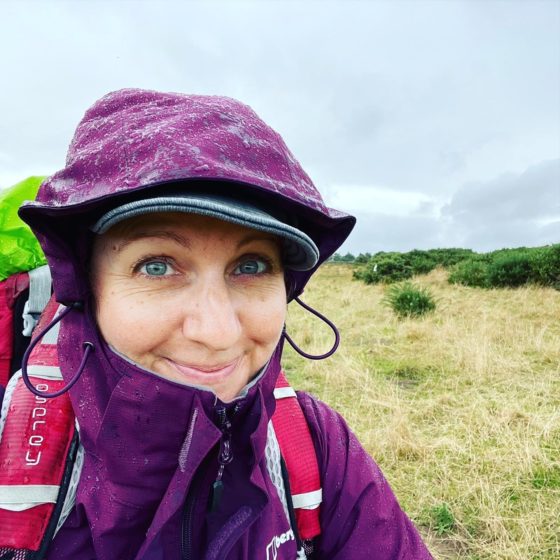
Essentially, I shared cover options with my patrons and some travel writers and they all picked one that had a ‘happy happy, joy joy’ vibe, but that is not the emotional truth of Pilgrimage!
I decided on one of my photos with a stormy sky and a mountain to climb. It fitted the Truth and the truth of the book, and as one of my own photos, it is authentic in every way.
TIP: Figure out your Truth (capital t) and try to make your truth (small t) as correct as possible, while still serving the story.
From my interview with Alastair Humphreys about his travel memoirs,
“I never make up stories of stuff that didn’t happen, but I often amalgamate a lot of different truths. So, lots of different memories of, say, campsites or perhaps different individual people I’ve met, I often amalgamate all of these things into one nugget of a story which serves to tell, more accurately, how the experience was at the time — and in a way, to make it more truthful. Not to make it more factual, but to make it more truthful.”
8. Use specific sensory detail
One of the key elements of travel writing is evoking a particular setting. A sense of place is critical for this genre.
But since Pilgrimage is a ‘lessons learned’ book as opposed to just a travelogue, I had to choose specific places to write about to illustrate each section, rather than a constant stream of description in each scene.
Our job as writers is to manipulate the mind of the reader. They should experience what we want them to through the details we choose to share.
Those details can be sensory description — sight, taste, touch, smell, sound — and you can enhance these with metaphorical, symbolic, emotional, or spiritual elements in order to deepen that sense of place.
One highlight of my three pilgrimages, and possibly the most spiritual of them all, was the crossing to Lindisfarne, Holy Island, which I share in chapter 2.3. A glimpse of the divine in sacred places.

I took a lot of photos as I walked across, but did not write about it until the next morning, and even then, my journal notes were sparse.
I wrote and rewrote this section many times for Pilgrimage. I wanted to share the physical and emotional truth of it and give a glimpse into how truly special this place is. If you ever get the chance, I highly recommend walking the sands to Holy Island.
I’ll share a section from the passage and highlight the sensory detail.
Walking across the sands to Lindisfarne, Holy Island
I rose before the dawn on the final morning of my pilgrimage on the St Cuthbert’s Way. I stood at a farm gate looking east into the rising sun, next to a field of curious alpacas and chickens [SIGHT] quietly clucking in their roost. [SOUND] As the darkness lifted, the castle on Lindisfarne stood in silhouette against bars of coral clouds, shot through with luminous yellow and pink as the sun rose above the horizon. [SIGHT]
The end was so close now.
I was relieved because my muscles ached and I wanted to stop and rest and not walk another day, but I was also sad that the journey was almost over. I wanted to finish the path, but also to keep going. Yet there is nothing beyond Lindisfarne, only the North Sea, and I would reach the furthest point that day. [EMOTION]
The clearing sky indicated that the weather would be fine for my crossing of the sands [SIGHT], but I still felt some trepidation. The tidal website warned it was only safe to cross with a guide, and there were tales of walkers lost to the sea in the fog, or cars stranded on the causeway as water reclaimed the land.
But I had prepared, and I knew it was safe to cross. All that remained was to step off onto the sands that the sea left behind.
As the sky turned pale blue, I returned to the farm to retrieve my pack, hefting it onto my shoulders for the last time. [TOUCH]
It was only a few kilometres from the farm to the edge of the causeway. I walked with Dave and Keith, pilgrims I had met a few days back after getting lost on the boggy moor. On the way down, Keith and I discovered we had both studied theology and read many of the same books. Whereas I had turned my degree into the basis of my thrillers, he had spent a life of service as a social worker, supporting those with mental health issues. We disagreed on matters of faith, but there was a spark of intellectual connection. [SOUND] Pilgrimage encourages the discussion of such deeper matters and I fleetingly wished we could carry on our debate. But we were soon at the edge of South Low, where the tide had turned and the waters were receding.
Several enormous concrete blocks lay just before the causeway, anti-tank sea defences from World War II. [SIGHT] There were signs warning of unexploded ordnance in the area as well as quicksand, and more warnings of what could happen if the tide cut you off. It was hard to imagine the military swarming over this area, now a National Nature Reserve, protected for the biodiversity of life within its shifting sands and tidal waters.
A series of marker poles stretched across the sand to Lindisfarne, interspersed by two wooden refuges on stilts for those who could not beat the tide. The sky was pale blue and clouds scudded high above, and I could see all the way to Holy Island. It was safe to cross. [SIGHT]
I rolled my walking trousers up above my knees. Walking barefoot was the traditional way to cross, but I had blisters and raw patches on my feet, [TOUCH] so I wore my walking shoes with waterproof socks. I grasped my poles to steady myself — then stepped off the causeway onto the sand. [TOUCH]
I wanted to walk the final stretch alone, so after taking photos with Keith and Dave, I let them stride ahead.
The sand was initially firm underfoot [TOUCH] as I followed the path of tall wooden poles towards Holy Island. I skirted around deeper pools of water, stepping over the wiggly casts of lugworms and the footprints of wader birds. [SIGHT] Gulls flew overhead, their calls piercing the air. [SOUND]
There were patches of grass in places and channels of deeper water to navigate, [SIGHT] with sections of sucking mud [SOUND] which I clambered through, using my walking poles to gain a more even footing. I almost lost one shoe in the mud, [TOUCH] and it was certainly a more challenging walk than I expected. Less a stroll across firm sand, and more an adventure to reach the final destination.
The lower parts of the wooden guide poles were covered with barnacles and bladder wrack seaweed, surrounded by winkle shells and long strands of sea grass. [SIGHT, SMELL] Crabs scuttled in the shallow water, trying to sink away from the light. The upper parts of the poles that lay above the tide were stark white, reflecting the morning sun, and I could imagine pilgrims spotting them with relief on a foggy crossing.
I stopped halfway across and turned my back on the causeway, looking south across the water to Bamburgh Castle in the distance. A mournful sound pierced the air, a low moan like a chill wind sweeping through ruins. [SOUND, METAPHOR] The call of grey seals out on the sand flats, singing as they have for generations of pilgrims. I was just one more in a long line stretching back through history, and my footsteps would wash away with the tide like all who walked here before me. [SPIRITUAL, EMOTIONAL]
The crossing took about ninety minutes, with time enough to navigate slowly around the mud and deeper water channels. I finally clambered up the bank on the other side and sat on a bench, looking back at the mainland as I changed into dry shoes. [TOUCH]
As with my arrival at Canterbury Cathedral a year ago, there was no fanfare, no one cheering the finish line of my pilgrimage. Only a quiet sense of satisfaction that I had accomplished what I set out to do. [EMOTION]
As writers, we all have our strengths and weaknesses. In reading this now, and analysing it after the fact, it underscores my strength — visual description — and also my weaknesses, sound and smell, in particular.
I am sensitive to sound, so am more often than not trying to shut it out with noise-cancelling headphones. I also lost my sense of smell with Covid and I don’t think it ever returned completely.
I walked across a few months after having Covid, so it’s possible I couldn’t smell the sea or the seaweed, but at least there is a mention of it. If I was rewriting this now, I would layer in more sound and smell, and also a few more metaphorical elements.
But overall, I’m happy with the passage and I think it gives a sense of the experience.
TIP: Use specific sensory detail to bring scenes alive.
If you need help with specific senses, you can use Sudowrite or ChatGPT or any of the AI tools to help you.
Check out my tutorial for Sudowrite where I talk about how to use the Describe function. Highlight a word and then ask it to Describe in more detail. The tool will return every sense and also metaphorical ideas.
9. The first draft and killing your darlings
I use Scrivener as my writing software and I ended up with several Scrivener projects for what turned into Pilgrimage, all started and left unfinished over the years.
The original project was called Untethered, and it was more a series of essays about my various travels and my search for the idea of ‘home.’ I turned these into solo episodes on my Books and Travel podcast, but I couldn’t find a thread to turn it into a book I wanted to write.
I started another project after the Pilgrims’ Way that was more a travelogue with a day-by-day account of the route and thoughts along the way. But once I wrote it all down, it seemed pointless. There are many guides already and I had nothing new to offer.
I kept typing up my journal entries, and I wrote thousands of words under chapter headings, some of which made it into Books and Travel episodes, others which still lie dormant, perhaps never to be used in a published work at all.
After I returned from the Camino, the book I wanted to write solidified in my mind.
I started a fresh Scrivener project and copied and pasted elements from all the old projects into it. I also added transcriptions of various solo podcast episodes and interviews I’d done on other shows, as well as typing up more journal notes from each trip.
In my initial phase of using Scrivener for any project, it is a chaotic mess.
I add placeholder texts for everything I can think of, and then I organize it and fill in the blanks later. It truly is wrangling chaos, and sometimes I just have to walk away and return when I can see clearly again.
As I work through each section, I move the older sections into the Research area, which means they are not included in the Compiled document, which I backup every day.
Here’s a screenshot from Scrivener with my Raw journal notes, which include practical things like the toilets at a supermarket as I thought I was writing a travel guide at that point.

It’s also a good example of not knowing what you will think is important until later. My notes mention ‘the surprising mural by Adam Kossowski’ in Peckham, but there are very few details in the journal. I took lots of pictures of it, which you can see here on Instagram.
In the finished book, it became part of chapter 2.2. Walking in the path of history puts life in perspective, where I expanded the description. The mural represented 2000 years of history, and one picture made it into the finished hardback. It was more important in retrospect, as it represented the historical aspects in both a metaphorical and physical way.
TIP: Don’t try to write in linear order. Just get everything down and then reorganise later.
Every time I finished a writing session, I exported from Scrivener into MS Word, backed that up on Dropbox, and also emailed it to myself.
You can watch a tutorial on how I use Scrivener for fiction and non-fiction here.
I also read a lot of books as part of my research. They gave a historical and religious perspective on pilgrimage, added to my knowledge about the benefits of walking and mental health, addressed midlife challenges, provided quotes to give extra resonance to the book, and helped me figure out where the book might fit in the ecosystem. I included the most useful in my Selected Bibliography at the back of Pilgrimage.
“In writing you must kill all your darlings.” William Faulkner
Once I had finished writing everything up, I had over 100,000 words of notes, thoughts, questions, quotes, research, journal pages, and ideas in my Scrivener project. Even once I had rearranged things, it was still a big book.
But when I read it from end to end with fresh eyes, I realized something significant.
From the reader’s perspective, it was full of repetition.
The final book includes one chapter on The Pilgrim’s Day, but of course my notes were aspects of this over and over again, and the same for aspects of hardship, where I combined all my ramblings about pain into one chapter.
The act of writing in a journal can be therapy, and it often is for me in daily life, but a finished book is for the reader.
The therapy is done, so leave it behind and reshape the words so they become something different.
If you are still writing for therapy, if you are still emotionally connected to the words, you will find it impossible to edit. Put the manuscript away and come back to it when you have some distance — and that might take longer than you think.
By the time I returned from my Camino, I had completed my character arc. I was on the other side of the experience and I could see what the finished book would be. I could then edit to fit that vision.
It serves no purpose for the reader if you include multiple instances of the same thing, so I removed tens of thousands of words to distill the manuscript down to its essence, and I reshaped the chapters into thematic elements.
This was incredibly difficult, and it took several passes before I honed the manuscript down to a slim 35,000-word draft.
I’ve never had to do this much word culling before. I usually write lean and have to expand. But this kind of writing was very different. What served me as I journaled each day differed from what served the reader as they read the book.
TIP: Write what you need to in your first draft, but serve the reader once you’re in editing mode.
Kill your darlings, cull your words, rid your manuscript of repetition. It’s hard, but it will make for a better book.
10. Publishing choices and formats
Publishing choices are always difficult, but a personal memoir is a particular challenge.
Yes, there are incredibly successful memoirs — Wild by Cheryl Strayed, and Educated by Tara Westover are two that spring to mind. They were traditionally published and became super successful, and rightfully so.
But there are countless numbers of memoirs that are published and don’t make a splash. They sink with barely a ripple. If you license your rights to a publisher and it is not successful, then you have lost control of what is a highly personal book that means a lot and you may regret your choice to let it go.
Self-publishing a memoir means the book stays in your control, and there are pros and cons with that choice too. I have spoken to many memoir writers who say that they are pleased they self-published as it meant they kept control of the book, could decide on the cover and marketing options, and generally were more comfortable being responsible for the book as it was so personal.
You can find more details on the specifics of how I professionally self-publish here.
Kickstarter
I’ve been focusing more on selling direct to readers over the last few years and I am pivoting my business to be ‘direct first,’ with some ‘direct-only’ products. I will still publish on the big retailers, but only once I have made money upfront first.
The goal with a Kickstarter campaign is to make a big chunk of sales upfront, and keep 95% of the profits. It is a lot of work and I will share my lessons learned on the campaign separately, but it was worth it for me, especially with this unusual personal memoir.
Some say that Kickstarter is like an advance from a publisher, because you get a chunk of cash near the beginning of the process. My campaign made almost £26,000, and there is no way a publisher would have paid that for such a niche book.
Once I have fulfilled the Kickstarter pledges, I will sell Pilgrimage from my JFPennBooks store for a month and then from 1 May, the ebook, audiobook, and black & white paperback will also be available on all other stores.
The goal is to take a bigger chunk of the revenue before the book is available everywhere, because of course the book platforms all take a cut of sale, so it’s better revenue-wise to sell direct first.
If you’re considering a Kickstarter campaign, it is much more complex than other forms of publishing, so please read Get Your Book Selling on Kickstarter by Russell Nohelty and Monica Leonelle. [Lots more resources here.]
Formats
I wanted a beautiful hardback with interior color photos as my primary format for the Kickstarter.
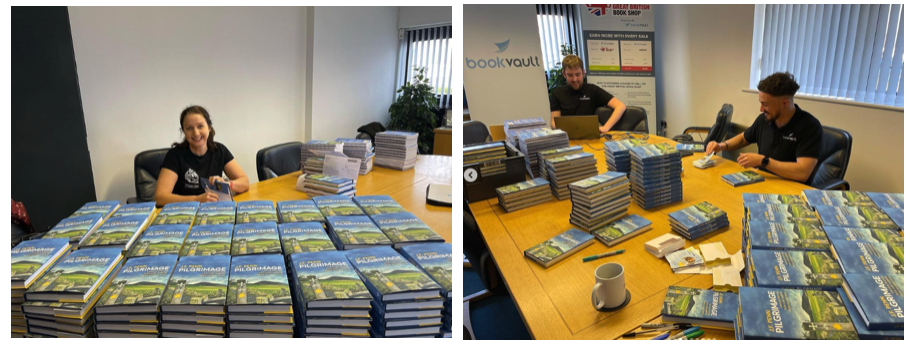
I also wanted a special paperback with color photos, and both of these will only ever be available through the Kickstarter and from my store, www.JFPennBooks.com (unless they are sold secondhand elsewhere).
I produced these with Bookvault.app who I also use for printing from my store. The print quality is fantastic and they have great customer service.
For the hardback specifics, the books are: Case Bound – Cloth, 115gsm Coated white paper, Buckram Paris Blue cover stock, Novel size (203 x 127 cm, 5 x 8 inches), Matte lamination, with 16 full-colour interior pages.
I have never used coated heavier paper before, but the printed interior colour photos look so good this way, so it’s worth doing if you want a similar quality.
As per usual, I also produced an ebook, self-narrated audiobook, black & white paperback, and a large print edition. These formats will be available on all the usual stores and published through KDP Print for Amazon and Ingram Spark for all other places, as well as through Bookvault for my store.
My designer, Jane, at JDSmithDesign.com worked with me to do the book design, and it was a challenging process to decide on the photos and get it all formatted.
We did it all before setting the Kickstarter live in order to get the final weight of the printed books which impacts shipping costs, an important thing to get right in the campaign.
I also used Midjourney to create a scallop shell ornamental break for the print and ebook editions.
Cover design
I went through an extensive process to decide on my final cover for Pilgrimage. First, I took screenshots of similar books across the travel genre and made a presentation for my cover designer, Jane, so she could see the type of thing I was aiming for. I also provided several of my own photos from the routes.
Jane came back with six alternatives, three of which used my photos.
I did a poll for the six with my patrons and asked some travel writer friends, and the overwhelming choice was a cover with blue skies, green grass and a happy feeling.
But it was not my picture, and I didn’t feel it was emotionally ‘true,’ in terms of the promise of this particular book.
It was important to me to use one of my pictures for such a personal book, and also to make it clear that the reality of pilgrimage (and mid-life) is more like climbing a mountain under stormy skies than skipping downhill in the sun without a care in the world.
I ultimately went with one of my own pictures from the St Cuthbert’s Way. You can see the entire cover design process with all the images here.
Narrating the audiobook
I’ve been narrating my own non-fiction books and short stories for years now, so I was always going to narrate my memoir. [You can listen to a sample here.]
Even if you hire professional narrators for your other books, you might still consider narration for your memoir, as it is such a personal book and many memoirs are narrated by the author.
However, I realise that for some, this might be a scary prospect. In an interview on writing travel memoir, Alastair Humphreys talked about his narration of My Midsummer Morning.
“I was absolutely dreading it. As I started to read, I was thinking, ‘This is going to be terrible, it’s going to be awful.’ I was really dreading that, but I was pleased. It was actually quite a good book. And so, I think it was a good experience to do and definitely worth doing. It really wasn’t much of a hassle at all.”
My specific tips for audiobook narration are in my book, Audio for Authors: Audiobooks, Podcasting, and Voice Technologies.
TIP: Think about what formats your audience might want, particularly for this special book, and how you might produce each. It might be different from your usual production process.
11. Marketing. Finding an audience for a different type of book
As Pilgrimage has been years in the making, and does not fit into my usual genres, I was unsure about how to market it, especially as (at the moment), I have no plans to write another travel memoir.
I must confess to being quite concerned about the marketing, since I have a book on the topic, How to Market a Book, and I have a reputation to protect. If Pilgrimage flopped, I would be seriously embarrassed and yes, I am afraid of failure and I have fear of judgment. Not an unusual situation for authors!
Usually with book marketing, it’s about writing books in a series, and using the first one to attract readers with promotions, so they go on to read others in the series.
Or if it’s a stand-alone book, there are usually other books which relate even tangentially to help with cross-promotion across an author’s name.
But Pilgrimage does not cross over at all with my non-fiction books under Joanna Penn, and it also doesn’t fit with my J.F. Penn thriller/dark fantasy audience.
Neither of my main email lists or audiences were the target market for Pilgrimage.
Of course, it’s still written by me, so those readers who want more of my writing in general would buy it, but I couldn’t count on selling many copies that way!
I decided to publish under J.F. Penn as there are religious and historical research elements in my fiction, and I also hoped that it might bring in new readers for my books as some of the pilgrimage sites are in the stories. Santiago de Compostela is in Stone of Fire, Lindisfarne is in Day of the Vikings, and Canterbury Cathedral is in Tomb of Relics.
My marketing for the Kickstarter launch period included:
- Talking about it on my Creative Penn Podcast for months in advance
- Setting up a pre-launch page on Kickstarter so people could sign up to be notified when it went live
- Getting my patrons and readers involved in things like cover design
- Emailing my two different lists multiple times in the preparation period and during the campaign — which resulted in many unsubscribes, which was fine with me! After all, email lists cost money so you want to keep the buyers, not just the browsers.
- Doing podcast interviews on other shows and publishing excerpts from them on my own show
- Sharing audiobook chapters on my Books and Travel Podcast
- Social media — mainly Twitter, Facebook, and Instagram
- Paid ads on Facebook, but not a significant amount (I spent £300 on ads)
I’m also planning to do another marketing push once the book is out on all platforms, including Amazon Ads to specific pilgrimage books and keywords, which hopefully won’t be oversubscribed because it’s such a niche topic. Plus Facebook Ads to a landing page on my Shopify store, JFPennBooks.com to continue fostering direct sales.
It’s quite good having different phases to the marketing, so I will do another wave in May 2023 for the ‘second launch.’
This very specific book doesn’t really fit with my existing backlist, but it is evergreen and can potentially reach a completely different audience to those I usually target with my other books.
I’m looking forward to being more creative with my marketing!
I hope these thoughts have been useful as you think about writing your own memoir, or perhaps doing a Kickstarter campaign for your book/s. Please do let me know any thoughts or comments below.
You can find more links to interviews and books on writing memoir here.
The post Tips On Writing Memoir With J.F. Penn first appeared on The Creative Penn.
Go to Source
Author: Joanna Penn

